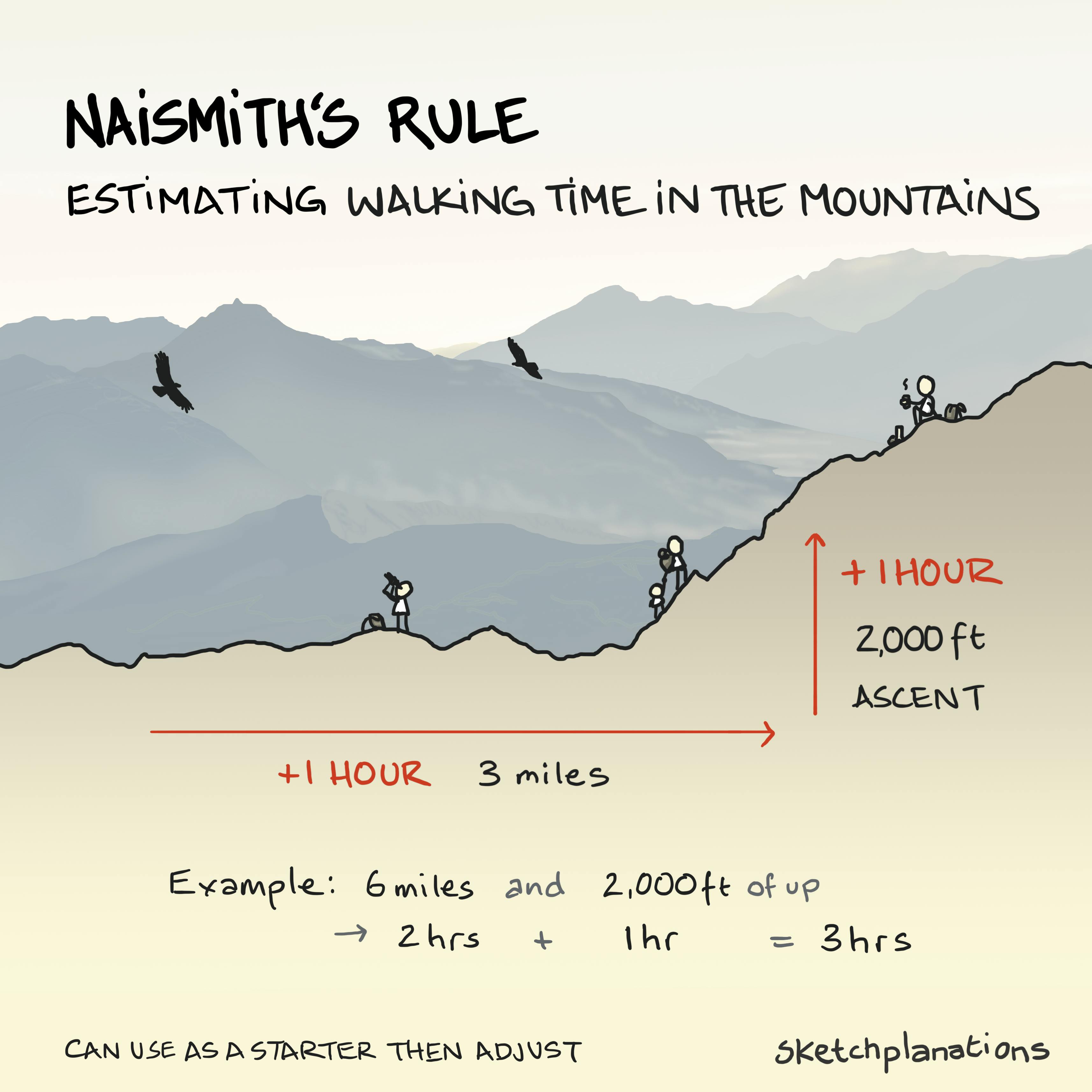Naismith's Rule for mountain hiking time

- Prints
- Copied!
👇 Get new sketches each week
Naismith's Rule provides a quick estimate for hiking time in the mountains, intended for "easy expeditions." It suggests:
- 1 hour for every 3 miles (5km) walked
- +1 hour for every 2,000 ft (600m) of ascent
For example, suppose your hike covers 6 miles with 2,000 ft of ascent. In that case, Naismith's Rule suggests allowing 3 hours total—2 hours for distance and 1 hour for elevation.
(Here's a metric sketch of Naismith's Rule )
Origins of Naismith's Rule
William Naismith was a Scottish Mountaineer born in 1856. He spent years trekking in the Highlands and was, to be fair, probably made of nails. In the Scottish Mountaineering Club Journal in 1893, he wrote:
"...a simple formula, that may be found useful in estimating what time men in fair condition should allow for easy expeditions, namely, an hour for every three miles on the map, with an additional hour for every 2,000 feet of ascent."
The Scottish Mountaineering Club Journal, Vol. II, September 1892, No.3, p.136 (pdf)
Does Naismith's Rule Work?
A figure I learned that's stuck with me is that a brisk walk is around 4 mph. But that's actually pretty fast and wouldn't apply on a mountain trail and certainly not hiking up a mountain. So I've run into the challenge myself when planning a trip in the mountains of how to guess how long a hike will likely take.
From a recent hike—where I made sure to run through the full kitchen table survival skills and 10 essentials before leaving—limited daylight was a safety consideration. So knowing how long the hike might take was really important. Incidentally, there's a rule of thumb, literally, for estimating remaining daylight.
Lots of people have put Naismith's Rule to the test, including me, and though it's a slightly optimistic metric, it's a starting point. On my recent hike, we were slightly over, but not by much.
Adjusting Naismith's Rule
To adjust for your circumstances, add time for:
- Tricky or technical terrain and trail condition
- Steep descents
- High altitude
- Lunches and snack stops
- Not being "in fair [physical] condition" in the view of a rugged mountaineer from Scotland in the 1890s
- Heavy packs, poor weather
- Getting lost
- Walking with children
- Photography, bird watching, animal spotting
- Time to stop and enjoy the views
- The size of your group—I have heard the rule of thumb to add 15 mins for each person in your group
- Sitting and sketching
- Presumably, if the hike was really long, you'd slow down
- The Unexpected
So, there are many reasons why Naismith's Rule may be on the light side. But it's a decent place to start from.
Killian Jornet Laughs in the Face of Naismith's Rule
Someone for whom Naismith's Rule definitely doesn't apply is the incredible Killian Jornet , whom I watched in the beautiful documentary Déjame Vivir on Netflix. Footage of him running along knife-edge ridges at the top of the Alps is breathtaking. In 2024, he hiked all 82 peaks above 4,000m in the Alps in 19 days without using motorized vehicles between them 🤯.
Lock-Miles
I was told about the term lock-miles, a kind of Naismith's Rule but for canal journeys rather than hikes. To estimate the journey time, you'd first calculate the lock-miles with the idea that it takes as long to travel through a lock as it does to travel a mile.
A journey of 10 miles with 5 locks would be 15 lock-miles. For experienced boaters, a typical speed might be 3 lock-miles an hour, so the journey of 15 lock-miles would take 5 hours.
Let me know if you give Naismith's Rule a try!
Prefer metric? So do I. Here's a metric Naismith's rule (with the approximate rounding)
Related ideas
Also see:
- The Fun Scale
- The 10 essentials
- Kitchen table survival skills
- Take photos of maps before a hike
- Use a compass
- Rule of thumb for remaining daylight
- Kaffikok — the time you can travel before needing another cup of coffee
- Time hierarchy
- Isochrones
- Human pace
I made some prints and products with and without the text in case, like me, you like a peaceful mountain ridge without any rules

